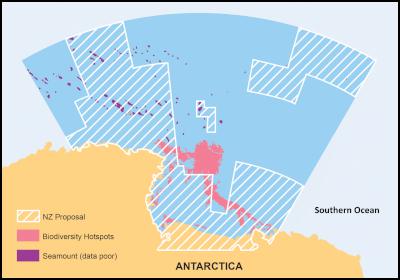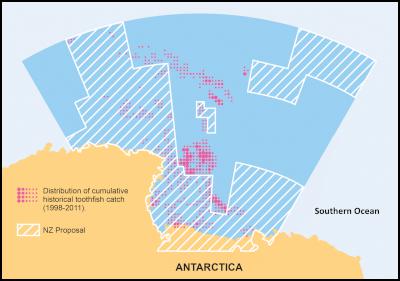Critical habitats missing from NZ Ross Sea reserve proposal

Click for big version.
Map 1: Comparison of the New Zealand Ross Sea marine reserve proposal and key biodiversity hot spots in the Ross Sea region. This map shows how the critical parts of the Ross Sea region are excluded from the marine reserve proposal. This data for this map is taken from the New Zealand proposal and data submitted to CCAMLR in 2010. A more detailed copy of the map can be found on page 14 of the Antarctic Ocean Alliance’s Ross Sea report, titled Antarctic Ocean Legacy: A Marine Reserve for the Ross Sea. Source data for identifying the biodiversity hot spots can be found at Ballard, G., Jongsomjit, D. and Ainley, D.G. 2010 Ross Sea Bioregionalisation Part II: Patterns of co-occurrence of mesopredators in an intact polar ocean ecosystem, CCAMLR Report, WG-EMM-10/12 Hobart, Tasmania.
Critical habitats missing from NZ Ross Sea marine reserve proposal - AOA
WELLINGTON, 12 September 2012 – An alliance of conservation and environment organisations spanning the globe has criticised New Zealand’s revamped Ross Sea marine reserve proposal as failing to show conservation leadership in international negotiations over the future of the region.
The AOA has mapped the New Zealand Government’s proposal against data showing the richness of life in much of the Ross Sea region. The map shows that core areas of the Ross Sea region have been excluded from the marine reserve to preserve fishing interests. The proposal contains a map that shows how carefully the lines on the map have been drawn to avoid the main fishing grounds.
“The New Zealand Government has taken great care to preserve fishing grounds; it’s disappointing that equal care wasn’t taken to protect the critical marine habitats of key Ross Sea wildlife,” said Antarctic Ocean Alliance New Zealand coordinator Geoff Keey.
“By focusing protection on those areas that aren’t fished and ignoring critical habitats inside fishing grounds, New Zealand is aiming to preserve the status quo while appearing to make a grand gesture for conservation.”
Keey said that Foreign Affairs Minister Murray McCully recently said ‘I would like to think that if we are going to move to putting a stronger priority on conservation issues that New Zealand would lead that charge’.
“Minister McCully’s Cabinet colleagues appear to have stymied his ambition and we hope they reconsider opportunities to show leadership over the next few weeks,” Keey said.
“If New Zealand is serious about creating a legacy for future generations in the Ross Sea it would be working with the United States to protect the critical habitats of the world’s least impacted ocean. Instead New Zealand appears to be campaigning to protect fishing.”
“The one silver lining is that New Zealand is proposing to protect the Scott Seamounts – undersea mountains that the Antarctic Ocean Alliance has identified as a priority for protection.”

Click for big version.
Map 2: Comparison of the New Zealand Ross Sea marine reserve proposal and key fishing grounds. This map is a reproduction of the map on page 5 of the New Zealand Ross Sea marine reserve proposal. It shows that New Zealand has excluded the areas with concentrated fishing effort, even where those areas have high biodiversity.
In less than 50 days, the Commission for the Conservation of Antarctic Marine Living Resources (CCAMLR) – the body that regulates fishing and protection of these waters – will meet in Hobart, Tasmania to debate proposals for Ross Sea protection.
“The Antarctic Ocean Alliance strongly encourages New Zealand and the US to continue to strive towards a joint proposal at CCAMLR in late October that provides real conservation leadership that all participating countries can support, while we have a window of opportunity to protect this incredible habitat,” said Keey.
“New Zealand has shown an intransigent approach to date and now needs to consider how it will avoid a train wreck at negotiations on Antarctic marine protection at the CCAMLR meeting later this year.”
Ends


 Gordon Campbell: On Why The US Stands To Lose The Tariff Wars
Gordon Campbell: On Why The US Stands To Lose The Tariff Wars YWCA: Global Push Back Against Gender Equality A Growing Crisis In Aotearoa
YWCA: Global Push Back Against Gender Equality A Growing Crisis In Aotearoa Te Pāti Māori: Ngarewa-Packer - Fast-Tracking Seabed Mining Ignores Māori Opposition And Environmental Precedent
Te Pāti Māori: Ngarewa-Packer - Fast-Tracking Seabed Mining Ignores Māori Opposition And Environmental Precedent New Zealand Defence Force: Defence And Customs Strengthen Maritime Security With Uncrewed Surface Vessels
New Zealand Defence Force: Defence And Customs Strengthen Maritime Security With Uncrewed Surface Vessels SPCA: Huge Win With New Dog Tethering Regulations
SPCA: Huge Win With New Dog Tethering Regulations Community Housing Aotearoa: Ngā Wharerau o Aotearoa Says New Partnership Model Helping Ensure Right To A Decent Home Is Realised
Community Housing Aotearoa: Ngā Wharerau o Aotearoa Says New Partnership Model Helping Ensure Right To A Decent Home Is Realised Greenpeace Aotearoa: Babies At Risk Due To Nitrate-Contaminated Drinking Water In Ashburton District
Greenpeace Aotearoa: Babies At Risk Due To Nitrate-Contaminated Drinking Water In Ashburton District


